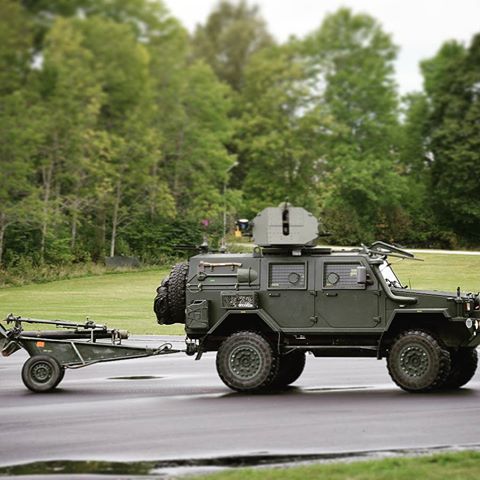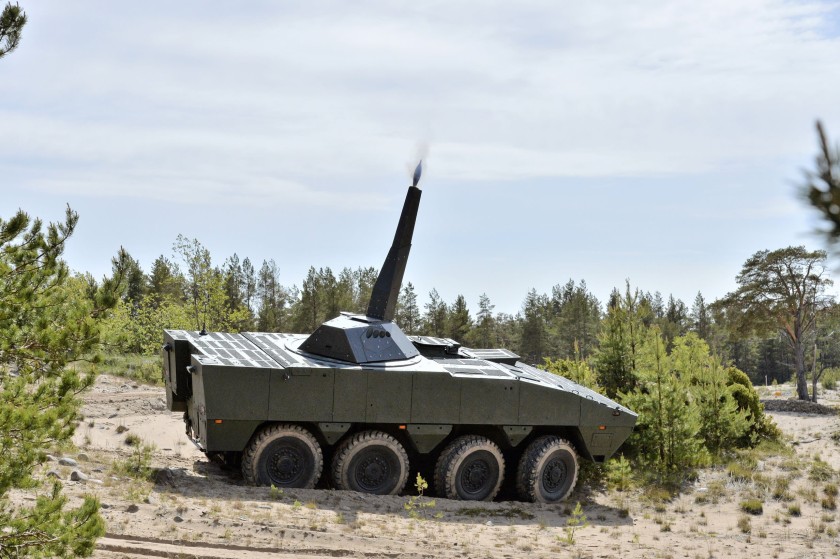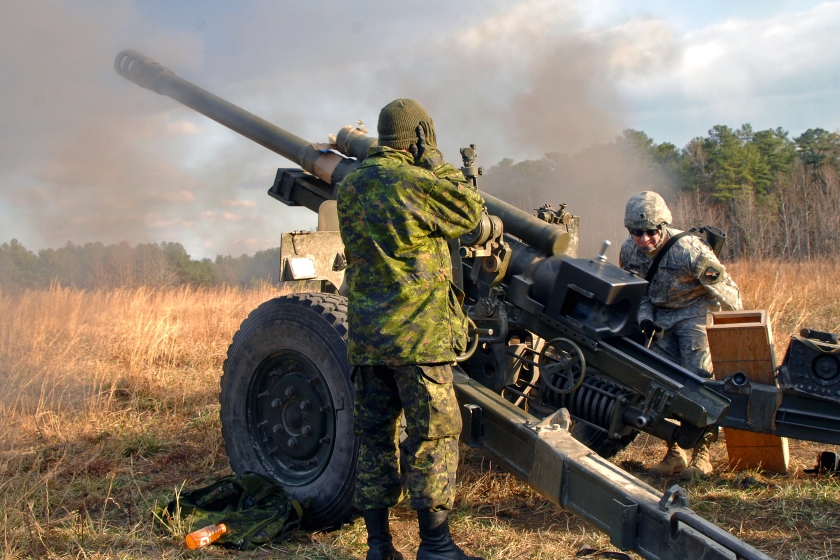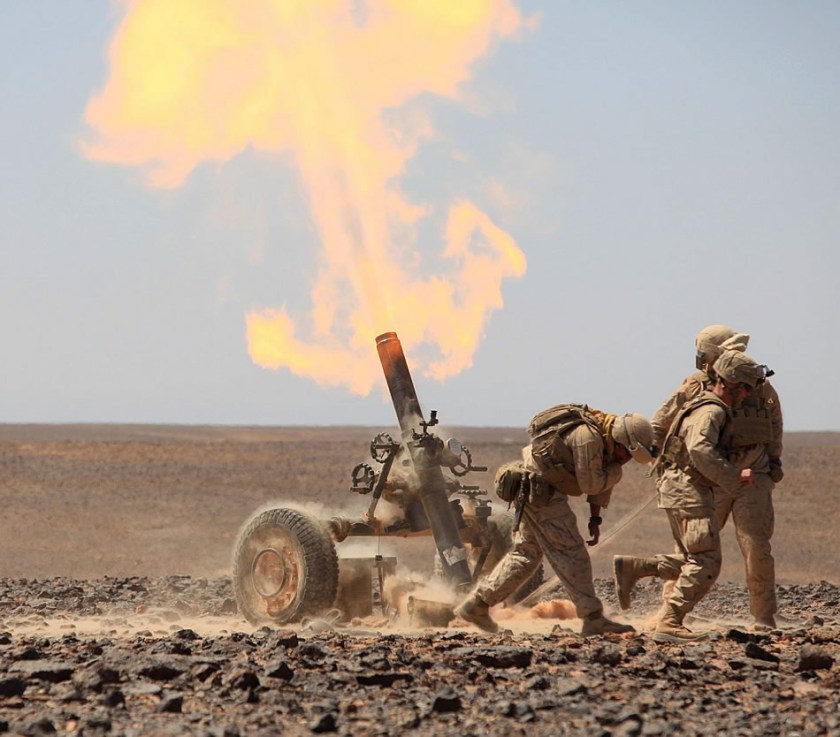By FinnishInfantryOfficer
This guest article is by a serving Finnish Army Officer, who prefers to remain anonymous. He is an authority on artillery and infantry weapon systems, as well as an active contributor to discussions on key defence topics.
Contents
01 – Introduction
02 – Review of current systems
03 – Comparison with other indirect fire weapons
04 – Conclusion
01 – Introduction
Mortars have been used for centuries, primarily as siege weapons. They differ from conventional artillery by firing projectiles at higher angles, at lower velocities, over shorter distances. Mortars as we know them today first saw light of day during WW1, when the British Army fielded the Stokes 3.2” (81mm) trench mortar. This had a smoothbore tube attached to a circular metal baseplate that was dug-in to the ground to absorb recoil. It had a range of 700 metres and could fire around 25 bombs per minute. Its stand-out feature was that it was truly man-portable.
Above: Stokes 3″ mortar. The first modern mortar from 1915.
After the war and especially during the 1930s, mortars in multiple calibres were honed into the shape and form they exhibit today. Mortar sights from the 1930s remain common and work seamlessly with mortar from 1990s. Advances in metallurgy and manufacturing combined with modern fire control systems that calculate range precisely, have improved effectiveness, reliability and robustness, but the fundamental design and operating concept remains unchanged.
Mortars are usually divided into three categories:
– Light Mortars, ranging from 51 mm to 82 mm,
– Heavy Mortars, usually means 120 mm;
– Super Heavy which refers to 240 mm or larger systems.
During World War 2, 3″ mortars (81 mm) were used widely. Since then, the 120 mm mortar has become a common standard across NATO. Indeed, the only major Western army not to use this calibre of mortar is the British Army.
02 – Review of current systems
The British Army still uses a modern version of the original 3” mortar developed by Stokes during WW1. The L16 81 mm mortar has been used since the mid-1960s. It is fully man-portable with the components divided into loads that can easily be carried dismounted. It has proved to be an extremely reliable system that delivers excellent effect. It has been mounted in the FV432 APC to provide a mobile firepower for infantry battalions.

The British Army later adopted a light 2” mortar for use at platoon level. This fired smoke and HE, but was of limited use due to its lack of accuracy. It was later replaced by a 51mm mortar with improved sights and ammunition.
More recently, the 60 mm Hirtenbirger mortar has seen UK service, but since it provides only marginally increased firepower over a 51mm mortar while weighing almost as much as an 81mm mortar, its utility is questionable.
The US, German, French, Italian and many other NATO armies have standardised around a heavy mortar of 120 mm. Primarily used in a towed application, 120 mm mortars are the most ubiquitous of heavy mortar systems in service today, thanks to their ease of use, low cost and low crew requirements. Such weapons have seen worldwide service over the last 50 years. You’ll even find insurgents making such mortars and ammunition in garages in Aleppo.

Typical range for a 120 mm towed smoothbore mortar is around 7.8 km using a 2 m barrel. Costs are typically around €370,000 per system. A 120mm mortar with towing kit weighs around 500kg. This is light enough to be hauled across short distances, but too heavy and bulky to be man-portable beyond a few hundred metres. The crew usually consists of 5-7 soldiers. Heavy mortars are usually operated either by infantry or artillery units and deployed according to the standard operating practices of each arm. More often than not, mortars will be owned by infantry units and as such are considered to be a battalion commander’s own “pocket artillery” with approximately 4 to 12 tubes issued per infantry battalion.
Self-propelled mortars existed during WW2, but were generally light weapons. Later, the Soviet 2S9 and a number of other successful post-war medium mortar designs saw service. The US Army mounted a standard 120mm mortar system in its M113 APC, which has now been transferred to its Stryker 8×8 infantry carrier vehicle. The Soviet Army developed the 2S4 Tyulpan 240mm self-propelled super heavy mortar. While offering supreme firepower, it has a slow rate of fire.

In the late 1990s. Finland and Sweden formed a partnership to design and produce a self-propelled mortar. The result was the AMOS 120mm system. This is a breech-loaded, double-barrel design with two 3 metre tubes. It has a 10km range, a Multiple Round Simultaneous Impact (MRSI) capability and a fully-automated fire control system. All of these attributes were unheard of before.

When Sweden dropped out of the programme, Finland was left to finalise development, but fortunately Sweden then adopted it. With the eventual price reaching an eye-watering €5 million per system, the AMOS system begs the question whether the money it cost to develop could have been better spent on some other artillery system? Original plans called for 24 systems in six mortar companies, each with 4x AMOS systems, but the final outcome was 18 in total with three per mortar company. The AMOS design led to its single-barrel brother, NEMO, which builds on the same system advantages making them the world’s most capable self-propelled mortar systems, at least for those with deep enough pockets.

03 – Comparison with other indirect fire weapons
As stated earlier, heavy mortars belong to either infantry or artillery units and this in turn dictates their relationship to other indirect fire weapons. They generally pack a bigger punch over a shorter distance. The obvious pecking order established by most countries that use such weapons is as follows:
– 60mm / 81mm mortars are used at company level
– 120mm mortars are used at battalion level
– 155mm howitzers are used at brigade level.
Declining numbers of soldiers in armies across the globe has seen the need to do more with less and often the solution has been mixed battalion battle groups. The basic premise is to take an infantry battalion and to add whatever supporting units are needed to execute a mission. This has brought tube artillery down to battalion level and, in some cases, stimulated a discussion about what the appropriate level of fire support for battalion-size battle group should be. If we strip the battalion of indirect fire weapons and add weapons that a brigade might have at its disposal, we’re left with following options with their pros and cons:
– 60mm mortar – low logistical footprint and truly man-portable, but short range (~3,800 metres) and limited effect, with minimum penetration of fortifications or buildings
– 81/ 82mm mortars – man-portable, efficient, with the highest ratio of number of kills per tonne of ammunition carried, but short-range (~5,600 metres) and limited effect
– 120mm mortar – very good effect: near misses can destroy lightly armoured vehicles, but only modest range increase over 81mm (~10,000 metres) and less portable
– 105mm howitzer – good range (~17,000 metres) and very good effect on par with 120mm mortar, but requires greater logical support, more crew training and is more difficult to transport
– 155mm howitzer – outstanding range and effect, but requires considerable logistical support including dedicated wheeled vehicles or self-propelled tracked platform.
Picture 1. Despite the apparent simplicity of the 120mm heavy mortar, it still needs a large amount of ancillary equipment, ammunition and has a crew requirement beyond what an RG-32 can carry.

Ultimately, the mission will dictate the ideal combination of weapons needed. It must also be said that a 120mm mortar is not necessarily a substitute for 105mm howitzers. Finland has adopted both a 120mm mortar and a 122mm howitzer in their new battlegroup structure. Together, they are a good example of what massed fires mean. A single battle group has an impressive 42 indirect fire weapons and is capable of firing 468 rounds per minute, if all weapons are aimed at a single target.
Like all towed weapons, heavy mortars suffer from inability to “shoot and scoot.” Of course, trained crews can mount and dismount their mortars quickly enough to qualify as mobile units under optimal conditions, but invariably real combat will introduce other factors that delay the un-packing and re-packing of equipment. Mounted heavy mortars, such as Cardom, have a quasi “shoot and scoot” capability through TALIN or other systems that feed fire control systems the mortars location, deflection and elevation at any given moment. More importantly, they allow the tubes to be dispersed making mortar units less susceptible to counter mortar fire. The downside as always is the price; towed weapon systems cost close to €1 million each, while wheeled platforms cost many millions and defeat any concept of simple and cheap artillery that mortars are supposed to offer.
The UK continues to use the L118 105 mm Light Gun. Compared to towed 120 mm mortar systems, this has double the range: 16-17 km. It has proved to be extremely useful and has seen considerable service across all British Army deployments over the last 30-40 years. it is now starting to show its age. As the UK considers the need to replace or least supplement the L118 105 mm gun, a towed 120 mm mortar could provide a worthwhile increase in capability at an attractive cost.

From a technical viewpoint AMOS and NEMO have caught up with 105mm howitzers. While having shorter range they can outgun any 105 with their MRSI and rate of fire. Also, they are inherently capable of “shoot and scoot” fire and movement, which cannot be said of towed artillery. Shorter range means being closer to the enemy, but also allows fire missions to commence with fire for effect, because external influences are fewer and computerised fire control ensures firing values will be accurate, leading to faster engagement times. Hitting a target with the first few rounds is much easier and more certain from 5km than from 13km. Also inherently smaller round dispersion, coupled with faster rates of fire favour the mortar when supporting troops in contact. It should be noted that even battalion battle groups should be able to conduct fire missions that reach an enemy’s rear area, even at ranges of 15 km behind the FEBA. Perhaps an ideal fire support composition for battalion battle group would be fire support battalion comprised of two batteries of 105mm plus a company of 120mm mortars. South Africans have very successfully mixed tube artillery, rocket artillery and heavy mortars into same organisation and there is much to learn from their methods.

04 – Conclusion
Towed 120mm heavy mortars will remain a primary source of firepower at battalion level for many years to come. Modern self-propelled mortar systems comprise about 1-2% of all heavy mortars used today and using them to replace the remaining 98% would require immense investment. Until then, armies will have to make do with what they have got and manage obsolescence by developing new tactics, adding subtle refinements, such as mortar mounted TALIN and other FCS systems. Irrespectivective of any enhancements, it still takes a painfully long time to dig a pit for a mortar base plate in frozen ground. However, mounted systems come at a cost and depleted forces with fewer numbers means a reduced ability to “make it rain.” A mortar company of 12 mortars can fire 144 rounds per minute, whereas a company of three AMOS vehicles can fire 36 rounds per minute. Choosing between towed and self-propelled systems is more subtle than just comparing a rate of fire of 144 versus 36 rounds per minute. A 120mm mortar system mounted in an 8×8 platform may be an ideal compromise, but may lack precision. Costs are between those of a towed system and NEMO.
Ultimately, this article is nothing more than a rough guide to current mortar systems; and it doesn’t exist to promote AMOS above other mobile systems. The objective is to highlight the trade-offs that need to be made between choosing a larger quantity of older, but capable and lethal legacy systems versus a smaller number of modern, efficient systems in any economically constrained environment. As is often said: quantity has a quality of its own.




It’s a good article, but I missed lots of points.
Picture seems to be missing: “Picture 1. ”
Same howitzer photo twice (and looks more like 105 mm IMO).
I noted an utter englect of counter-mortar locating radar capability; 105 mm shells and rifled 120 mm mortar shells are less easily detected and measured than 120 mm mortar bombs.
I noted that dispersion problems (uncertain wind conditions plague mortars more, long dispersion pattern in lower register plagues howitzers more) were neglected.
De facto inability of fin-stabilised mortar bombs to make use of RAP (wind issues) wasn’t mentioned (but to be honest, I never blogged on that either).
The importance of illumination should be mentioned. The new IR ILLUM rounds help only those with NVGs and other near-IR night sights by illuminating the battlefield in a way that’s not visible to the naked eye. This is fairly new and not yet icnorporated into most Western land forces AFAIK.
It’s clealry no Schwerpunkt activity, so there’s a strong case for making it the job of organic (platoon to battalion) indirect fires. It might even be the best justification for platoon-level commando mortars.
Prices offered for towed mortars (per piece and with vehicle) differ so much that certain assumptions should be clarified (I suppose a hardened 4×4 vehicle was assumed).
Recent Swedish move away from too elaborate AMOS to another SP 120 mm mortar wasn’t mentioned.
Troubles with recoil from 120 mm mortars on wheeled (and alson tracked) platforms have been neglected (some vehicles can be shaken apart by the recoil, and mitigating it means to add a recoil mechanism akin to what a 105 mm hwoitzer has).
105 mm SPGs and tanks with high maximum elevation 105 mm gun turrets that can double as SPGs were neglected. 105 mm SPGs were quite a thing in the past before NATO stnadardised on 155 mm (possibly with ICM/DPICM in mind) – remember the Abbot.
“Towed 120mm heavy mortars will remain a primary source of firepower at battalion level for many years to come.”
Or maybe they’ll be massacred by counterfires in the next major war between modern armies and become considered as obsolete as blue uniforms and battle cavalry by ’15.
LikeLike
“It’s a good article, but I missed lots of points.”
To me it seems like you’ve said yourself “It’s an article, not a paid 50 grand study”.
But agree, mortars face the possibility of detection and counterfire. Is the threat bigger than artillery would face, hard to tell. Depends on what the enemy ranks higher.
LikeLike
Arty would often be out of range and is usually SP and shoot & scoot capable now. Effective counterfires against SPGs or even MRLs require so much sophistication that their process would likely not be reliable enough to justify the effort.
I suppose bipod mortars would get hammered because they lack shoot & scoot (for mediums there wouldn’t be much ground to use within range anyway) and thus CAN be hit. Anything less mobile than those 120 mm portée mortars that can be lowered and raised on the rear of a pickup should better be a commando mortar. Their small projectiles with very low apogee are less susceptible to radars.
LikeLike
Let me ask you one thing. How far away from lead battalion do Russians put their artillery battalion or same with Germany or USA? What is the planned range from furthermost maneuver element when they come into contact? 5, 10, 15, 35km?
LikeLike
I’ve never seen any written preferred distance, but 18-22 km distance to target is well-liked because it’s possible with good dispersion, standard HE (no BB or RAP) with some coice of elevations (MRSI possible) and standard SMK works as well (I doubt there’s any BB or RAP for SMK available at all / there are few mortars in the Heer).
I highly doubt anyone in the German field manual writing teams would dare to suggest that trying to keep a certain distance to the most forward battalion would make much sense.
LikeLike
Ok, no further questions.
LikeLiked by 1 person
Well, I’ll be, Freedom and Defence! Fancy seeing you here.
So is there a chance you can delve a bit into the vagaries of modern indirect fire problems with maybe a longish post on your own website, or maybe a rebuttal piece for this one? ‘
As far as my dilettante-ish brain can tell, this Finn did a great job explaining the bare bone basics, and I’d like to hear more. From him and you.
If I could ask you to explain it, I’s like to bring the cost/benefit analysis into sharper focus: One topic I didn’t see in this general discussion on price was the coldest, meanest calculation of all: the lives of soldiers. Are modern armies really losing a lot of money by having higher price 3 to 5 million Euro systems that may take as few as 2 (extremely expensive) soldiers to man them versus a French legacy mortar that only costs 300,000 Euros but takes 5 to 7 soldiers plus more ancillary manpower? I’m not pushing an agenda, I literally have no idea. Which is why I ask.
My admittedly dumb yank understanding is that ALL Western democracies put around a million Euro’s into training ANY soldier. I severely doubt an Austrian artilleryman costs much less to train than a yank. Or even a Czech artilleryman, for that matter. When I look at a precious battalion that I’m trying to fill out with scarce resources, I just wonder if I can afford to lose those four or five extra riflemen I desperately need to the artillery.
Anyway, good comment. I still read your blog…or at least the non-political part of it.
LikeLike
FinnishInfantryOfficer,
Do you have any experience with AMOS or NEMO in direct fire mode? Specifically, how does accuracy compare to tank guns or tube artillery in direct fire mode? I would expect tanks to win out at longer ranges.
LikeLike
I think Patrias brochure mentions something about little over 1000m with 1x1m accuracy IIRC.
LikeLike
That kind of dispersion was already available in 1945 with 8 cm PAW 600, which used old-style mortar bombs as projectiles at IIRC about 550 mps.
750 m distance dispersion on 1×1 m target.
LikeLike
To be honest why would you need better accuracy from a mortar? To me that seems more than adequate.
LikeLiked by 1 person
I know it’s someone off topic, but I’ve often wondered about breach-loading mortar as a HIFV armament ala BMP-3, along side a 30mm cannon.
I realize such a turret would be rather expensive, so probably would never happen.
But, in theory, it could fire the full suite of mortar bombs, an anti-tank/anti-UAV missile, perhaps even a tandem HEAT round , a canister round, and a tube-launched UAV like Cutlass.
http://www2.l3t.com/uas/products/r_cutlass.htm
If MBTs eventually go to the larger, heavier 130mm gun, they’ll have room for even fewer HE/HEAT/MPAT multi-purpose rounds. A gun-mortar on IFVs could supplement them.
A mortar turret has greater elevation , as well as a shorter barrel than MBTs. Both are useful qualities in urban environments
Imagine an IFV company providing supporting mortar fire for another company in the battalion. 14 NEMO-level tubes could rain down a lot of mortar bombs in a short period of time. Maybe not as good as dedicated mortar vehicles, but quantity has a quality of its own.
Obviously training gunners in indirect as well as direct fire missions would be an issue. But perhaps a lot of the indirect side could be automated.
All pie in the sky fantasy, I know.
LikeLiked by 1 person
France, South Africa and Israel use breech loaded 60mm mortar on number of AFV. I think 81mm would be good size for such weapon to accommodate large enough HEAT/MP warhead in direct fire role. I can think of quite a few reasons why dual role in this situation would be bad and having dedicated indirect support unit is better but I think breech loaded mortar for close in direct support and ability to shoot smoke and illumination indirectly would be very beneficial.
LikeLiked by 1 person
81mm isn’t big enough to fire an effective ATGM.
Also, 81mm might be too small to create breach holes in rebar-reinforced concrete. It’s unclear if a 120mm mortar HE round would be good at this either, but at least it’s bigger.
What are some reasons why dual role wouldn’t be a good idea?
I could see having both. Have dedicated 120mm mortars as primary indirect fire assets, but also 120mm Gun-Launcher-Mortars (GLMs) on IFVs to provide supplementary indirect fires, direct support to infantry, and long range, anti-tank missile fire.
Kind of a Swiss army knife HE tosser.
LikeLiked by 1 person
Of course if we could have both that would be good. The problems I see are C2, logistics, availability and planning the units use.
120mm rounds are pretty bulky, also the barrel and breech would take a lot of space so will there be space left for infantry or other weapons ammo? Would the vehicle be dedicated for fire support? I’m not convinced about the need to launch missiles from this thing. Firing position requirement differ greatly for missiles and mortar. I would prefer something with either 20mm or gatling .50cal with and 81mm breech loaded, two per MIV/Stryker/equivalent company. In permissible environment they can use all weapons to support infantry and against peer enemy they could park close by behind cover and lob IR smoke to cover infantry advance.
LikeLiked by 1 person
The Nemo turret is almost comically small for the size of the gun, so I can’t imagine the breech takes up that much space. For the GLM implementation, I would redesign it to store ammunition in a bustle rack rather than the hull. A two-man turret with a 30mm and 120mm together would certainly be larger than just a 30mm turret alone. But how much more it would intrude into the passenger area is unclear.
120mm mortar bombs are much smaller than TOWs, which are carried in the troop compartment of Bradleys, and are manually loaded by dismounts from the rear compartment. Not ideal.
Maybe you lose one dismount, or increase the size of the vehicle, but you gain a very flexible weapon. Trade-offs.
Obviously no such system exists, so the $$ needed to build it would likely put it out of reach. And it seems like the US Army would prefer a simpler solution. They don’t even seem to care much about going from 25mm to 30mm, and were willing to dump the ATGM launcher on the GMV.
If MBTs stay with 120mm guns for the time being, perhaps the need to have a supplementary direct-fire HE tosser is lower. But if we move to 130mm, and go from ~40 rounds stowed to ~30-35, tanks will have a harder time carrying a useful mix of sabot and MP.
LikeLiked by 1 person
What ?
LikeLike
“Ultimately, this article is nothing more than a rough guide to current mortar systems; and it doesn’t exist to promote AMOS above other mobile systems.”
“The AMOS design led to its single-barrel brother, NEMO, which builds on the same system advantages making them the world’s most capable self-propelled mortar systems”.
Unfortunately, these 2 statements seem to contradict each other since the author, despite being a professional in the field of mortars, mysteriously forgot to mention the RAK system, being easily just as good as AMOS/NEMO are.
https://www.army-technology.com/projects/rak-120mm-self-propelled-mortar-system/
LikeLiked by 1 person
I’m the first to admit that stated technical aspects to any weapon system aren’t the only measure of their true effectiveness, but the system as advertised (by you, I hasten to add) isn’t even as impressive as the standard older American Stryker systems, much less the more whizz-bang Scandinavian ones like the AMOS and NEMO and even simpler and cheaper ones ones like the Mjolner:
For instance:
– the range for the RAK is the same for literally ALL 3 meter barrels. There is nothing new here.
– The Holy, All Important Rate of Fire: The stated 6-8 shot per minute burst capability (which was repeated in BOTH your sources, so I tend to believe you and them) is HALF the American Stryker program’s output of just 6 to 8 rounds a minute. Nope, sorry, less than: the yanks have SIXTEEN rounds a minute:
http://www.military-today.com/artillery/m1129_stryker_mortar.htm
Now admittedly, it has a better 8 kilometer HE range than the American system (a two meter barrel at 6.8 km), but the AMOS has the same range as the RAK and has a TWENTY FOUR round per minute burst:
http://www.military-today.com/artillery/amos.htm
AND it has the same range. So that’s a three to FOUR times the firing rate as the brand new RAK in a system where ROF is basically the most important metric.
AND they both carry more ammunition standard: RAK carries 46 rounds, the American’s carry 60 and the AMOS carries 50 to 60. Oh, and the single barrel NEMO has a 10 round burst, not 6 to 8 like the RAK.
Again, there ARE imponderables that can make a design better or worse in combat, and I’m not saying their aren’t: but do the Poles really have a more advanced fire control center than the yanks or the Finns? From designs that were only fielded a few years ago? I’m leery of the prospect,
I know for a fact the TALIN 5000 is a good fire center, but it’s also unremarkable in an arena with a number of really good ones. Finns and yanks especially are known leaders in fire control systems, and have been since trench’s were in vogue.
I’m entirely willing to be disabused of my ignorance, but I just can’t reason out how the RAK system is even as good as a slightly older American system, much less the state-of-the-art AMOS’s, NEMO’s and Mjolner’s.
What are you seeing that I can’t?
LikeLike
I do not know why my first comment on this matter finally did not appear here, but – despite what the author stated – NEMO/AMOS are not the best on the market, since there is also the Polish RAK.
https://www.armyrecognition.com/poland_polish_army_artillery_vehicle_and_system_uk/rak_120mm_8x8_self-propelled_carrier_armoured_vehicle_technical_data_sheet_specifications_pictures_11204165.html
Even though the English sources are scarce about this system and/or contain errors: the above link is the best what I could find in English, but here is the link to the Polish source describing RAK’s correct rate of fire: 7-10 rounds/minute (the same as NEMO’s).
http://www.defence24.pl/7824,mozdzierz-samobiezny-rak-kalibru-120-mm
LikeLiked by 1 person
Ok, I didn’t see this: if what you are saying is true, it…..well, changes nothing.
Assuming the best interpretation is correct: it’s 10 rounds per minute and not “7 to 10”, literally everything I said remains in effect and changes nothing about my assessment or reasoning: at 10 rounds it merely puts it on par with the least of the 4 I mentioned: the Mjolner, M1129 Stryker and NEMO are all clearly superior, if we trust the press on them. And hell, the yank’s system even carries a second 81mm mortar for dismount.
And your higher ROF only puts it on par with the NEMO If the imponderables are just as good. Which, as I said, I have my doubts: the NEMO still carries more ammunition AND has better standard armor protection than the RAK’s Rosmorok body. Now, I don’t think it’s terribly important overall, but ALL FOUR of the ones I compared RAK to have better protection than the STANAG 1 protection which comes standard on the RAK.
So even as the least capable of the four I compared to the RAK, the NEMO still has better protection and more ammunition in a game where ammo load is certainly very important.
I’m not being facetious or a know-it-all, I just want to see where I am not getting it. Please, tell me why I’m wrong.
LikeLike
Interesting that UK MOD is announcing the end of the 60mm mortar as a platoon weapon (along with the withdrawal of the LSW and LMG). If they are replacing it for something more effective, or as effective but with other advantages (lighter) then great, but I hope it’s not a loss of firepower overall.
LikeLike
What about short range mlrs, like ex Yugo M63 “plamen” 128mm, 20kg per rocket, 12.8km range.It’s ideal batralion level weapon?
LikeLike
Oh, I forgot to ask the actual writer: are 107mm still around, or did they go the way of the dodo and passenger pigeons?
I did notice that a lot of systems that were based on the larger 107 were phased out in American circles in favor of the larger calibers: I’m wondering if that was the general consensus now: I can understand why having 3 instead of 4 types of rounds to distribute could be a kind of “force multiplier” for the logistics guys: I can’t really guess what battle niche the 107 had in the first place.
LikeLike